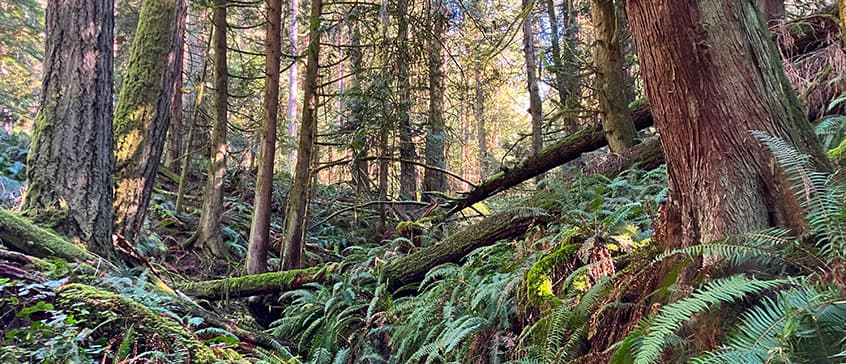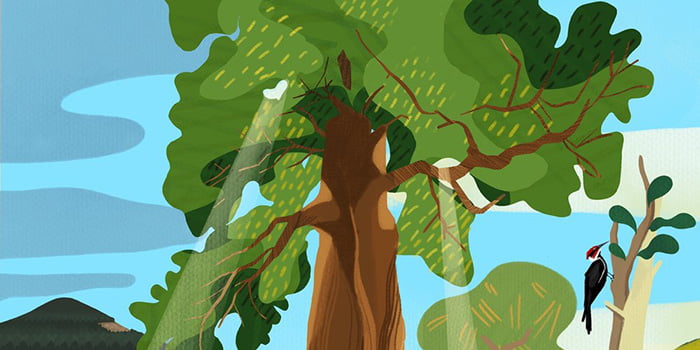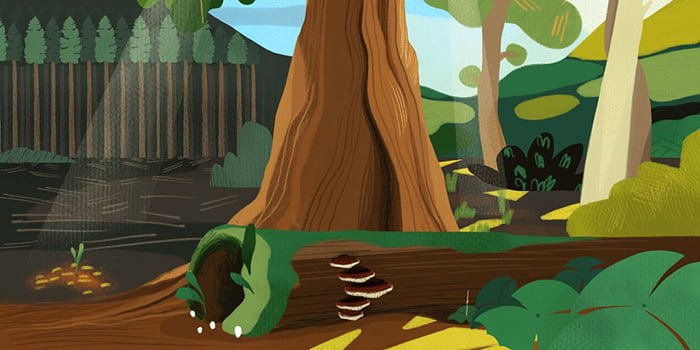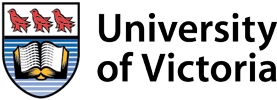Home / Science and the Environment / Uncovering design principles for future ecologies
Uncovering design principles for future ecologies

By instructor Adam Huggins
At this point, we all know what it feels like: the need to escape from the infernal devices delivering us a daily flood of social and environmental crises, and go "touch grass." But since for most of us, the nearest grass is in the form of a lawn—and a lawn is a meagre substitute for a functioning ecosystem—let’s take a walk together in the forest instead.

The Growing Need for Ecological Restoration
As we walk, let’s marvel at this strange moment in time, when even those of us with the least regard for what we refer to as the "environment" has likely gained a basic awareness that the forest around us is more than just a collection of trees—but rather a web of relationships linking soil to sky through fibre, foliage, fungi and countless interactions between living things, both large and small. We’ve never held a greater collective appreciation for the complexity and preciousness of the ecosystems around us, and yet at the same time these ecosystems have never before been under greater threat. The forest around must now adapt to climate change, provide us with a wide range of ecosystem services, furnish material for us to build our way out of a housing crisis, and continue somehow to support all of the other species we ostensibly share it with—all while recovering from what are often decades, or even centuries, of extractive mismanagement.
How can we possibly ask so much from ecosystems that have been damaged, degraded or even destroyed? Aldo Leopold once wrote that "one of the penalties of an ecological education is that one lives alone in a world of wounds." In his time, an ecological education was a rare thing, but today more and more of us find ourselves surrounded by gaping wounds in the fabric of the natural world. Many of us are searching for ways to help heal these wounds, and fortunately for us, the nascent discipline of ecological restoration that Leopold helped to seed has now evolved into an impressive toolkit for planetary repair. Impressive, but also bewildering, for the tools in the toolbox include such strange bedfellows as sand and sticks, excavators and inoculant, UAVs and ungulates, rifles and reconciliation.

Documenting Community-Led Healing
 In 2018, a self-described "recovering industrial designer" and I sought to chronicle our quest to find the common thread running through all of these seemingly disparate attempts to reboot our relationship with the "natural" world. Over six seasons of the Future Ecologies podcast, we’ve documented communities working together to restore ancestral sea gardens, organizing to "rematriate" Indigenous lands, mobilizing to extend rights across species and militarized borders, and experimenting with prescribed fire and managed grazing to prevent wildfires and recover ecosystems. Again and again, we’ve found people coming together to integrate western science, Indigenous knowledge, novel technologies, and traditional wisdom to restore ecosystems and address the often “wicked" problems we face as a species.
In 2018, a self-described "recovering industrial designer" and I sought to chronicle our quest to find the common thread running through all of these seemingly disparate attempts to reboot our relationship with the "natural" world. Over six seasons of the Future Ecologies podcast, we’ve documented communities working together to restore ancestral sea gardens, organizing to "rematriate" Indigenous lands, mobilizing to extend rights across species and militarized borders, and experimenting with prescribed fire and managed grazing to prevent wildfires and recover ecosystems. Again and again, we’ve found people coming together to integrate western science, Indigenous knowledge, novel technologies, and traditional wisdom to restore ecosystems and address the often “wicked" problems we face as a species.
More than anything else, sharing these stories of people working to manifest future ecologies that we actually want to live in has demonstrated that we may live in a world of wounds, but we are no longer alone. There is so much we can learn from each other, and so many opportunities to reach across cultural, political and economic divides to improve our shared reality. And as we learn to listen to one another, we are increasingly learning to listen directly to natural systems themselves. What can observing natural processes teach us about how to design a better future for ourselves and our communities?
Towards a "Pattern Language" for Natural Systems Design
Several years ago, a close friend gifted me a remarkable book published in the 1970s called A Pattern Language. In it, a group of architects crafted a set of principles to govern the design of human infrastructure from the scale of doorknobs up to metropolitan regions, drawing on careful study of patterns in successful human design interventions throughout history. In the 1980s, permaculture emerged as an attempt to articulate a similar set of principles for agriculture and the design of human-centered ecologies. This raises the question: what would it look like to articulate a "pattern language" for the design of natural systems themselves—a set of principles and practices for ecological restoration based on observation of natural patterns?
When pioneering plant ecologist Dave Polster delivered the first iteration of a class called "Design Principles for Natural Processes" in 2008 at the University of Victoria, he began to answer this question. Building on Dave’s work by drawing on my own hands-on restoration practice and explorations of Future Ecologies, I’m honoured to once again offer a course designed to help you identify the wounds in the world around you, pick up a box full of now-familiar tools, and work collaboratively to help heal the planet and your community.
Because the future ecologies that I aspire to will afford us more than just the ability to periodically "touch grass"—they’ll feed us, shelter us, teach us, inspire us and heal us. We won’t know where "they" end and where "we" begin.

If you’re passionate about working in the field of ecological restoration, come learn how to build new practice-based skills and knowledge. Our specialized Ecological Restoration (ER) certificate and courses will help you learn how to identify problems in current environmental practices, and explore ways to investigate alternative and innovative solutions. All courses include a wholistic balance of theory and the most current restoration practices taught by experienced and knowledgeable instructors. The next ER course offering is: ER 501, Design Principles for Natural Processes.
For more details on how to apply to the program or register for individual courses contact us: bstadmin@uvic.ca.
About Adam Huggins
Adam is the Restoration Coordinator for the Galiano Conservancy Association on Galiano Island, where he designs and implements restoration projects using a range of approaches. He holds a BSc in Biology and Environmental Studies from the University of Victoria, as well as a Diploma in the Restoration of Natural Systems. Over the past decade, he has worked from central California to the north coast of BC in plant nurseries, on restoration projects, and in remote fieldwork. He produces and co-hosts the Future Ecologies podcast, and is also an avid backpacker, musician, and naturalist.
- Posted June 30, 2025
RELATED TOPICS: Ecological Restoration
Latest News
- Bringing the world of AI to everyone
- Playing for the planet: Tackle climate change together
- A full-circle success story: ELC alumni return two decades later
- Managing crises and finding opportunity in the uncertainty
- Orange Shirt Day & National Day for Truth and Reconciliation
Visit Registration
2nd Floor | Continuing Studies Building University of Victoria Campus 3800 Finnerty Road | Victoria BC | CanadaTel 250-472-4747 | Email uvcsreg@uvic.ca
2025 © Continuing Studies at UVic
Legal Notices |
Sitemap

